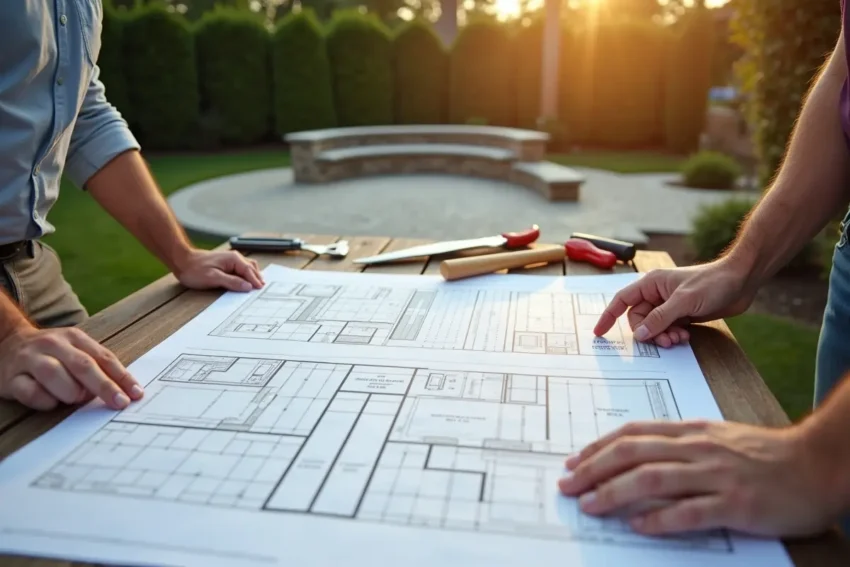Building a patio can be an exciting project, offering opportunities for relaxation and entertainment right in your backyard. This outdoor space can serve as an extension of your living area, providing a perfect backdrop for family gatherings, barbecues, or quiet evenings under the stars.
Before you pick up your tools or hire a contractor, certain steps must be taken to ensure your project complies with local regulations and is built to last. Understanding the aspects of construction, such as site preparation, legal requirements, and design considerations, will set your patio up for success.
Understanding Zoning Regulations
Local zoning laws determine how you can use your land, including what type of structures can be built and where they can be placed. One of the first steps in building a patio is understanding zoning rules that may apply to your property. These rules can vary significantly depending on your municipality and even your neighborhood.
You might be required to maintain a certain distance from property lines or adhere to height restrictions. Before you proceed, it’s wise to check with your local governing body or planning department. Many provide online resources or even personal consultations to clarify regulations. Familiarizing yourself with these regulations guides you in designing a functional and compliant patio that fits within your community’s standards.
Designing Your Patio
Designing a patio involves more than just picking out materials. Consider the aesthetic of your home and how the patio will integrate with the surrounding landscape. A patio should enhance your outdoor space rather than detract from it. Take into account factors such as existing trees, gardens, and the layout of your yard when planning. Think about the intended use of your patio. Will it be a space for entertaining, dining, or simply relaxing with a book? You may want to include features like seating areas, pathways, or even a fire pit.
Planning must align with both your needs and your local guidelines, ensuring that the design adheres to zoning requirements set forth by local authorities. Choosing materials is also a critical design consideration. Opt for sustainable materials that can withstand the elements while providing the look you desire, whether it’s natural stone, pavers, or concrete. Each material has its advantages and will impact the atmosphere of your outdoor space.
Site Preparation
Site preparation is an important phase that lays the groundwork for your patio. Begin by selecting a spot that receives ample sunlight and fits within your zoning allowances. Remove any vegetation, debris, or existing structures, carefully examining the soil type to determine suitability for supporting your new patio. Depending on local inspection requirements, you may need to get a surveyor involved to ensure the land is stable and can accommodate the weight of your chosen materials.
Once the area is cleared and leveled, consider grading the ground to promote proper drainage. This step prevents water pooling, which can lead to structural issues down the line. For most patios, a foundation of gravel or sand is recommended for drainage and stability. This crucial phase cannot be rushed. Taking the time to prepare the site properly will pay off in the durability and longevity of your finished patio.
Legal Permits and Inspections
After you have a final design and have prepared your site, the next step is to secure any required legal permits. Most municipalities require permits for structures like patios, particularly if they exceed a certain size or feature permanent installations. The permitting process can involve submitting your designs for review and may include inspections during and after construction.
Failure to obtain the necessary permits can lead to fines or removal of your patio, so it’s vital to approach this stage methodically. Your local planning office can provide information on the types of permits you may need and how to apply. Keep in mind that maintaining compliance throughout the construction process is not just about legality. It’s about ensuring safety and quality in your build.
Building Your Patio
With permits in hand, you can begin the actual construction of your patio. Depending on your skills, you might choose to tackle this as a DIY project or hire professional contractors. Keep in mind that every construction project involves risk, so if you are unsure about any stage of the process, it’s prudent to hire experienced contractors to avoid costly mistakes.
Depending on your design choice, your construction process may involve laying a solid foundation, installing borders, or creating drainage features. The choice of installation techniques can vary significantly based on the materials chosen, and it is advisable to follow manufacturer guidelines or seek expert advice to ensure durability.
Enhancing Your Patio Experience
Once your patio is constructed, consider how to maximize its potential. Outdoor lighting can create ambiance, making the space usable in the evenings. Incorporating plantings and soft furnishings can provide warmth and comfort, while features such as awnings or pergolas can offer shade and aesthetic appeal.
Don’t forget about the practical aspects as well! Invest in good furniture that can withstand weather conditions, and consider storage solutions to keep your patio organized and clutter-free. Personal touches, such as decorations or artwork, can make the space feel inviting and unique to your style.
Planning, constructing, and enjoying a patio takes thought, effort, and investment, but the results are usually well worth it. With thoughtful design and adherence to local regulations, you can create an outdoor space that enhances your lifestyle and adds value to your home.

